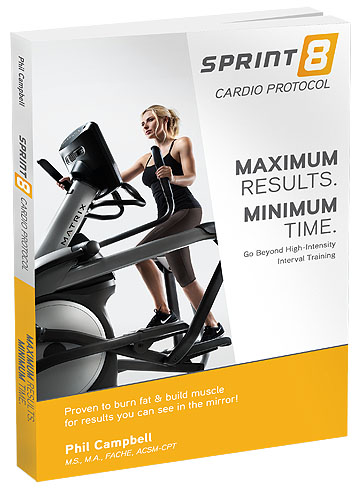| rrr |
|
Is your HIIT Class really HIIT?
Probably not
By Phil Campbell, M.S., M.A., ACSM
HIIT is the hottest workout worldwide according to the American College of Sports Medicine. No wonder. Research shows HIIT (High Intensity Interval Training) produces superior results to all other forms of exercise and people see and feel results in just a few weeks. They see results -- if they are doing HIIT correctly. The problem is most are not.
It appears everyone has jumped on the HIIT bandwagon. They are calling any type of oscillating work/rest, work/rest kind of workout HIIT. However, what many people are doing today and calling it HIIT doesn't come close to the productive level of HIIT in the research. The current interpretation of “HIIT” is so misleading that I have had to change the nomenclature of the Sprint 8 Cardio Protocol in my books to “sprint cardio" as a step up from HIIT so people understand the difference. A few researchers are now calling this level of intensity “SIT” for “sprint-intensity cardio” to distinguish it from all the so called HIIT programs popping up. Just because an exercise program is hard, this doesn't make it sprint cardio or even HIIT. To know if you are doing sprint cardio and the productive version of HIIT, which is clearly shown to get superior results in the shortest time, it’s necessary to understand a little science behind what makes the sprint cardio and the real version of HIIT so productive. The exercise has to be all-out, hard and fast. Working hard and moving slow isn't HIIT. The reason why is simple. Slow movement, even though it’s hard, doesn't’t recruit all three muscle fiber types -- Slow, Fast and Super-Fast muscle fiber– to propel the movement during an exercise. You have to recruit a lot more muscle fiber than just the slow fiber so your heart muscle has to work very hard attempting to oxygenate a lot more muscle fiber to qualify as sprint cardio and HIIT. What you don’t know about HIIT Whether I’m working with a Ricardo Lockette or a Julian Edelman, who have several Super Bowl rings, or Mac McClenny, my 97-year-old step dad who, by the way, needs to work all three muscle fiber types and both processes of his heart muscle as he actively ages, the human body always sends slow-muscle fiber to accomplish the task (or exercise) first. When the brain senses that your slow fiber, approximately half your muscle fiber, isn’t adequate to accomplish the task, the brain very quickly recruits the first layer of fast fiber (type IIa) that moves five times faster than the slow. This extra fiber jumps in to assist the movement when it’s called on. However, when the brain senses that this first layer of fast fiber is inadequate to accomplish the task of an all-out sprint for example, the brain very quickly recruits the super-fast fiber (type IIX) that moves ten times faster than the slow. At this level of fast and hard sprint-intensity movement, you have now forced your brain to do something it is not accustomed to doing -- unless you consistently train like a sprinter. You are now recruiting all three muscle fiber types to propel the exercise. This takes focus to accomplish because your brain thinks it’s doing you a favor NOT to recruit fast fiber so it can do things all day with slow fiber in the endurance energy system. Your brain is actually trying to conserve your fast-muscle fiber from being used in case you need it later for an emergency situation. When you are going as fast and hard as you can during a cardio exercise, and it's so hard you can’t possibly last longer than 30 seconds, this is sprint-intensity cardio. This is the true level of HIIT intensity that gets superior results. At least it was just a few years ago. Sprint intensity cardio and true HIIT means your heart muscle and lungs are not just trying to oxygenate the big muscles in your legs and your upper body. Your body is now trying to oxygenate twice the muscle fiber used in normal exercise. You have to recruit a lot more muscle fiber to oxygenate to be sprint cardio. Pacing is the enemy of intensity It takes real focus to keep the brain from pacing during HIIT. Even for the most experienced, it takes constant focus to keep from pacing and performing an exercise with more than slow fiber propelling the movement. Pacing is leaving muscle fiber out of the process and this is the enemy of intensity. Pacing is movement propelled by slow-muscle fiber in the endurance energy system, and this is default position for human movement. It takes mental focus, max effort with high-velocity hard exercise to force the brain to recruit all three muscle fiber types. Understanding the basics of HIIT can be performed sprint running, sprint swimming, or with an all-out cardio sprint effort on most pieces of cardio equipment. There has to be an all-out, high-velocity movement along with being hard (via resistance) to be sprint cardio and true HIIT because all three muscle fiber types have to be recruited where the heart muscle works so hard that you can’t possibly go longer than 30 seconds. Sprint 8 running is 8 reps X 60 meters (or 70 yards on a football field). Sprint 8 swimming is sprint swimming 25 meters all-out UNLESS you are a trained swimmer with great technique. For the trained swimmer with efficient technique, you have to make the flip and sprint swim 50 meters to equal the same intensity of most swimmers with 25 meters. What ever form of cardio sprinting you use, you have to be totally spent in 30 seconds or less, or don’t count the rep. 30 seconds OR LESS Rule The “30-Second Rule” used in the Sprint 8 Cardio Protocol is if you can go longer than 30 seconds, don’t count it. Don’t count that rep because you have unintentionally paced if you can go longer than 30 seconds. Pacing is the enemy of intensity and it’s means recruiting muscle less muscle fiber. Following 30-Second Rule OR LESS ensures you are recruiting all three muscle-fiber types so your heart muscle has to work hard anaerobically and aerobically. Now you are conditioning both processes of the heart muscle, the aerobic and the anaerobic. The second way to know if your HIIT is the real deal is in the amount of recovery in between the 8 cardio sprints. Active recovery is moving at the pace of a casual walk and it is a full 90 seconds. With the exception of very specific training for athletes, if you rush the 90-second recovery and make it less, you just made the workout moderate intensity exercise. The reason why is simple. Your fast fiber isn't recovered and you won’t be able to go all-out of the following cardio sprint. You may do the first couple of cardio sprints correctly, but if you rush the recovery, it’s not giving you the intensity needed to be sprint cardio. You need all three fiber types recovered so you can go all-out on all 8 cardio sprint reps. If you can still go all-out on the coming cardio sprint with less than a 90-second active recovery, this means you unintentionally paced on the previous rep and didn't’t recruit all three muscle fiber types to propel the movement. 90 second active recovery I've tested 30, 60, and 90-second recoveries and by far 90 seconds is much more intense because your fast fiber is now recovered enough where you can truly go all-out during the next cardio sprint. A one minute on / one minute off program is not sprint intensity after the first couple of reps. Ten seconds on / ten seconds off is not sprint cardio after the first few reps. This may be a hard workout, but you missed the intensity necessary for sprint-cardio results because you left the fast-muscle fiber on the sidelines. Bottom line, if you are not needing a 90-second active recovery after a cardio sprint, you paced. Don’t count that rep as a cardio sprint. The Sprint 8 Cardio Protocol in my books on a tradtional piece of cardio euqipment is eight reps of all-out cardio sprint beginning with two reps per workout and slowing and progressively building to all eight reps. If you are doing it correctly, it will be very difficult to make the full 30 seconds, and this means you did it correctly! In 30 years with Sprint 8, I’ve only seen around ten, highly-conditioned athletes do all 8 reps the right way, the first time. When to add strength training For strength training, you can do 30-seconds on / 30-seconds off for functional strength training and boot camp types of training, after your sprint cardio, and this is extremely positive for numerous reasons cited in my new book the Sprint 8 Cardio Protocol. Doing sprint cardio first and getting the ridiculously intense 20-minute program out of the way is very positive as the rest of the workout is all fun (after about two weeks when you are conditioned). There are many benefits of doing strength training with your body full of exercise-induced growth hormone generated during the Sprint 8 workout. This is sprint cardio. This is real HIIT. This is working all three muscle fiber types and both processes of the heart muscle. This is by far the most productive form of exercise. But you have to ease into a sprint cardio program because it’s classified as anaerobic exercise. It’s the most productive form of exercise, but also the most dangerous. It’s important to progressively ease into the program. And it’s always a good idea to get your physician’s clearance before doing any type of exercise program.
*Testimonials
are individual experiences reflecting personal experiences
of those who have used our information and programs. Individual
results vary.. More info on disclaimer here
|
 |


